View in other NatureServe Network Field Guides
NatureServe
Montana
Utah
Wyoming
Idaho
Wisconsin
British Columbia
South Carolina
Yukon
California
New York
Black Swift - Cypseloides niger
State Rank Reason (see State Rank above)
Species is limited in distribution and requires very specific waterfalls for nesting which are rare on the landscape. Species appears to be somewhat stable in occupancy and faces significant threats from drought and changing hydrology, which may cause loss of waterfall nesting sites.
General Description
The Black Swift is the largest of the swift species north of Mexico but the least studied. This species nests exclusively on ledges or shallow caves on steep rock faces behind waterfalls and is unique among swifts in laying only one egg per clutch (Lowther and Collins 2002).
For a comprehensive review of the conservation status, habitat use, and ecology of this and other Montana bird species, please see
Marks et al. 2016, Birds of Montana.Diagnostic Characteristics
They are over 7 inches in length and have wingspans up to 18 inches. As the name implies, Black Swifts are completely dark in appearance. A distinctly notched tail on the adult male is the only difference in appearance between the sexes. They have long, broad-based, and curved wings, similar to hummingbirds. The tail is square and often fanned. Juveniles are similar in appearance to adults, except for the small bands of white present across much of the underbody (neck, belly, and undertail coverts). The wingbeats are slow and shallow, often looking erratic in flight when foraging (Sibley 2014).
The coloration of Black Swifts distinguishes them from White-throated Swifts (Aeronautes saxatalis), which have broad white markings on the chin, neck, breast, and sides of the rump. Black Swifts are much larger, have longer tails and are darker than Vaux's Swift (Chaetura vauxi). The same is true in comparison to Chimney Swifts (Chaetura pelagica), which also barely overlaps in range with Black Swifts.
Species Range
Montana Range
Range Descriptions
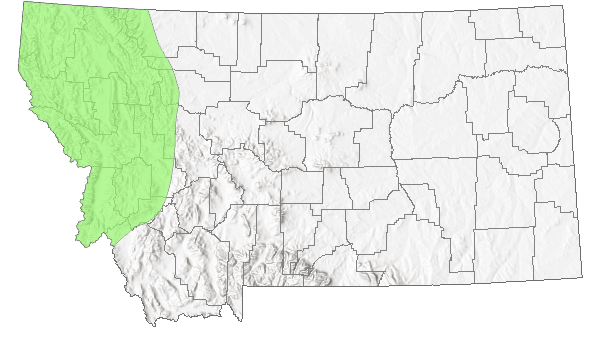
 Summer
Summer
Western Hemisphere Range
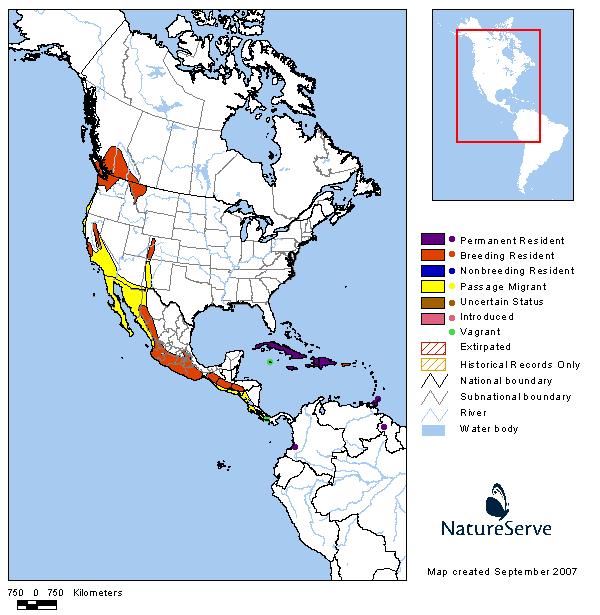
Observations in Montana Natural Heritage Program Database
Number of Observations: 948
(Click on the following maps and charts to see full sized version)
Map Help and Descriptions
Relative Density
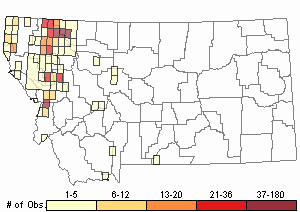
Recency
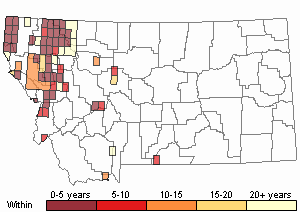
SUMMER (Feb 16 - Dec 14)
Direct Evidence of Breeding

Indirect Evidence of Breeding

No Evidence of Breeding

WINTER (Dec 15 - Feb 15)
Regularly Observed

Not Regularly Observed



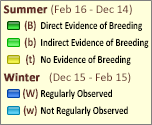 (Observations spanning multiple months or years are excluded from time charts)
(Observations spanning multiple months or years are excluded from time charts)
Migration
Little information regarding the migratory patterns of Black Swifts exists for Montana. Birds have been observed in migration as early as May and as late as August (Montana Bird Distribution Committee 2012). All observations of migration or transitory behavior have occurred in the western part of the state, usually in areas where mountainous habitat exists including the Lolo Peak area in Missoula County, Lee Metcalf National Wildlife Refuge, and the National Bison Range (Montana Bird Distribution Committee 2012).
Habitat
Like other swifts, Black Swifts forage over open areas often over bodies of water, often at long distances from the nest (Collins and Peterson 1998). They nest behind or next to waterfalls on steep cliff faces (Lowther and Collins 2002). Nesting locations share the following characteristics: water, high relief, inaccessibility to predators, unobstructed flyways to and from the nest, and darkness (Lowther and Collins 2002).
National Vegetation Classification System Groups Associated with this Species
Alpine
Alpine - Sparse and Barren
Sparse and Barren
Sparse and Barren
Food Habits
Black Swifts feed on flying insects and arthropods, particularly winged ants. Swifts forage in the air, often at great heights, particularly in good weather. Apparently concentrate along low pressure weather systems, which may also concentrate aerial insects (Lowther and Collins 2002).
Ecology
Suitable nest sites are limited; birds nest singly or semicolonially depending on availability of sites (Lowther and Collins 2002).
Reproductive Characteristics
The Black Swift has strong fidelity to nest sites, and new nests may be built directly atop previously used nests (Lowther and Collins 2002). The nest is a cup composed of mud, mosses and liverworts, pine needles, and twigs (Hunter and Baldwin 1962). A single egg is laid in June to July. Both parents visit the nest throughout the breeding season, but the division of incubation and brooding duties is unknown. The incubation period is long, at 26 days (range 22-32 days). The nestling phase averages 48 days (range 40-58 days; Gunn et al. 2012). Once fledged, it is assumed that young migrate with adults (Lowther and Collins 2002).
Management
No active management currently is in place for Black Swifts in Montana, although decreases in water flow and increased recreational use in areas where Black Swifts nest, or are thought to nest, should be discouraged (Casey 2000). Additionally, reduced snow packs and earlier spring thaw and runoff could reduce stream flows.
Stewardship Responsibility
References
- Literature Cited AboveLegend:
 View Online Publication
View Online Publication Casey, D. 2000. Partners in Flight Draft Bird Conservation Plan Montana. Version 1.0. 287 pp.
Casey, D. 2000. Partners in Flight Draft Bird Conservation Plan Montana. Version 1.0. 287 pp. Collins, C.T. and B.M. Peterson. 1998. Nocturnal chick provisioning by black swifts. Western Birds 29:227-228.
Collins, C.T. and B.M. Peterson. 1998. Nocturnal chick provisioning by black swifts. Western Birds 29:227-228. Davis, D. G. 1964. Black swifts nesting in a limestone cave in Colorado. Wilson Bulletin 76:295-296.
Davis, D. G. 1964. Black swifts nesting in a limestone cave in Colorado. Wilson Bulletin 76:295-296. Foerster, K. S. and C. T. Collins. 1990. Breeding distribution of the black swift in southern California. Western Birds 21:1-9.
Foerster, K. S. and C. T. Collins. 1990. Breeding distribution of the black swift in southern California. Western Birds 21:1-9. Gunn, C., K.M. Potter, and J.P. Beason. 2012. Nest microclimate at northern black swift colonies in Colorado, New Mexico, and California: temperature and relative humidity. Wilson Journal of Ornithology 124:797-802.
Gunn, C., K.M. Potter, and J.P. Beason. 2012. Nest microclimate at northern black swift colonies in Colorado, New Mexico, and California: temperature and relative humidity. Wilson Journal of Ornithology 124:797-802. Hunter, W. F. and P. H. Baldwin. 1962. Nesting of the black swift in Montana. Wilson Bulletin 74(4):409-416.
Hunter, W. F. and P. H. Baldwin. 1962. Nesting of the black swift in Montana. Wilson Bulletin 74(4):409-416. Knorr, O. A. 1961. The geographical and ecological distribution of the black swift in Colorado. Wilson Bulletin 73(2):155-170.
Knorr, O. A. 1961. The geographical and ecological distribution of the black swift in Colorado. Wilson Bulletin 73(2):155-170. Knorr, O. A. and M. S. Knorr. 1989. The black swift in the Chiricahua Mountains of Arizona. Southwest Naturalist 35:559-560.
Knorr, O. A. and M. S. Knorr. 1989. The black swift in the Chiricahua Mountains of Arizona. Southwest Naturalist 35:559-560. Legg, K. 1956. A sea-cliff nest of the black swift. Condor 58:183-187.
Legg, K. 1956. A sea-cliff nest of the black swift. Condor 58:183-187. Lowther, P. E., and C. T. Collins. 2002. Black Swift (Cypseloides niger). In The birds of North America, No. 676 (A. Poole and F. Gill, Eds.). Academy of Natural Sciences of Philadelphia and American Ornithologists’ Union.
Lowther, P. E., and C. T. Collins. 2002. Black Swift (Cypseloides niger). In The birds of North America, No. 676 (A. Poole and F. Gill, Eds.). Academy of Natural Sciences of Philadelphia and American Ornithologists’ Union. Marks, J.S., P. Hendricks, and D. Casey. 2016. Birds of Montana. Arrington, VA. Buteo Books. 659 pages.
Marks, J.S., P. Hendricks, and D. Casey. 2016. Birds of Montana. Arrington, VA. Buteo Books. 659 pages. Michael, C. M. 1927. Black swift nesting in Yosemite National Park. Condor 29:89-97.
Michael, C. M. 1927. Black swift nesting in Yosemite National Park. Condor 29:89-97. Montana Bird Distribution Committee. 2012. P.D. Skaar's Montana bird distribution. 7th Edition. Montana Audubon, Helena, Montana. 208 pp. + foldout map.
Montana Bird Distribution Committee. 2012. P.D. Skaar's Montana bird distribution. 7th Edition. Montana Audubon, Helena, Montana. 208 pp. + foldout map. Sibley, D. 2014. The Sibley guide to birds. Alfred A. Knopf, New York, NY. 598 pp.
Sibley, D. 2014. The Sibley guide to birds. Alfred A. Knopf, New York, NY. 598 pp. Stiles, F.G. and A.F. Skutch. 2003. A guide to the birds of Costa Rica. Comstock Publishing Associates, Cornell University Press, Ithaca. 511 pp.
Stiles, F.G. and A.F. Skutch. 2003. A guide to the birds of Costa Rica. Comstock Publishing Associates, Cornell University Press, Ithaca. 511 pp. Vrooman, A. G. 1901. Discovery of the egg of the black swift (Cypseloides niger borealis). Auk 18:394-395.
Vrooman, A. G. 1901. Discovery of the egg of the black swift (Cypseloides niger borealis). Auk 18:394-395.
- Additional ReferencesLegend:
 View Online Publication
View Online Publication
Do you know of a citation we're missing? Altman, B. 2003. Inventorying Black Swift nesting populations at waterfalls in the Northern Pacific Rainforest Bird Conservation Region. American Bird Conservancy, Corvallis, OR.
Altman, B. 2003. Inventorying Black Swift nesting populations at waterfalls in the Northern Pacific Rainforest Bird Conservation Region. American Bird Conservancy, Corvallis, OR. American Ornithologists’ Union [AOU]. 1998. Check-list of North American birds, 7th edition. American Ornithologists’ Union, Washington, D.C. 829 p.
American Ornithologists’ Union [AOU]. 1998. Check-list of North American birds, 7th edition. American Ornithologists’ Union, Washington, D.C. 829 p. Casey, D. 2004. Coordinated bird monitoring in Montana. Special species monitoring: Black Swift. Prepared for the Montana Bird Conservation Partnership and the University of Montana. American Bird Conservancy, Kalispell, MT..
Casey, D. 2004. Coordinated bird monitoring in Montana. Special species monitoring: Black Swift. Prepared for the Montana Bird Conservation Partnership and the University of Montana. American Bird Conservancy, Kalispell, MT.. Chantler, P. and G. Driessens. 1995. Swifts: A guide to the swifts and treeswifts of the world. Pica Press, Sussex, England. 237 pp.
Chantler, P. and G. Driessens. 1995. Swifts: A guide to the swifts and treeswifts of the world. Pica Press, Sussex, England. 237 pp. Colorado Partners in Flight. 2000. Physiographic Region 62: Southern Rocky Mountains.
Colorado Partners in Flight. 2000. Physiographic Region 62: Southern Rocky Mountains. Dobkin, D. S. 1992. Neotropical migrant landbirds in the Northern Rockies and Great Plains. U.S.D.A. For. Serv. N. Region Publ. R1-93-34. Missoula, Mont.
Dobkin, D. S. 1992. Neotropical migrant landbirds in the Northern Rockies and Great Plains. U.S.D.A. For. Serv. N. Region Publ. R1-93-34. Missoula, Mont. Dobkin, D.S. 1994. Conservation and management of neotropical migrant landbirds in the Northern Rockies and Great Plains. Univ. Idaho Press, Moscow, Idaho. 220 pp.
Dobkin, D.S. 1994. Conservation and management of neotropical migrant landbirds in the Northern Rockies and Great Plains. Univ. Idaho Press, Moscow, Idaho. 220 pp. Ehrlich, P., D. Dobkin, and D. Wheye. 1988. The birder’s handbook: a field guide to the natural history of North American birds. Simon and Schuster Inc. New York. 785 pp.
Ehrlich, P., D. Dobkin, and D. Wheye. 1988. The birder’s handbook: a field guide to the natural history of North American birds. Simon and Schuster Inc. New York. 785 pp. Hays, R., R.L. Eng, and C.V. Davis (preparers). 1984. A list of Montana birds. Helena, MT: MT Dept. of Fish, Wildlife & Parks.
Hays, R., R.L. Eng, and C.V. Davis (preparers). 1984. A list of Montana birds. Helena, MT: MT Dept. of Fish, Wildlife & Parks. Hejl, S.J., R.L. Hutto, C.R. Preston, and D.M. Finch. 1995. The effects of silvicultural treatments on forest birds in the Rocky Mountains. pp. 220-244 In: T.E. Martin and D.M. Finch (eds). Ecology and Management of Neotropical Migratory Birds. New York, NY: Oxford Univ. Press. 489 p.
Hejl, S.J., R.L. Hutto, C.R. Preston, and D.M. Finch. 1995. The effects of silvicultural treatments on forest birds in the Rocky Mountains. pp. 220-244 In: T.E. Martin and D.M. Finch (eds). Ecology and Management of Neotropical Migratory Birds. New York, NY: Oxford Univ. Press. 489 p. Hendricks, P. 2005. Surveys for animal species of concern in northwestern Montana. Unpublished report to the Montana Department of Fish, Wildlife & Parks, Montana Natural Heritage Program, Helena, Montana, May 2005. 53 p.
Hendricks, P. 2005. Surveys for animal species of concern in northwestern Montana. Unpublished report to the Montana Department of Fish, Wildlife & Parks, Montana Natural Heritage Program, Helena, Montana, May 2005. 53 p. Hunter, W.F. and P.H. Baldwin. 1972. Black swift nest in Glacier National Park. The Murrelet 53(3):50-51.
Hunter, W.F. and P.H. Baldwin. 1972. Black swift nest in Glacier National Park. The Murrelet 53(3):50-51. Johnsgard, P.A. 1992. Birds of the Rocky Mountains with particular reference to national parks in the northern Rocky Mountain region. Lincoln: University of Nebraska Press. xi + 504 pp.
Johnsgard, P.A. 1992. Birds of the Rocky Mountains with particular reference to national parks in the northern Rocky Mountain region. Lincoln: University of Nebraska Press. xi + 504 pp. Johnson, P.W. 1990. Black swift (Cypseloides niger) nesting in the Jemez Mountains of New Mexico. New Mexico Ornithological Society Bulletin. 18:13-15.
Johnson, P.W. 1990. Black swift (Cypseloides niger) nesting in the Jemez Mountains of New Mexico. New Mexico Ornithological Society Bulletin. 18:13-15. Joslin, Gayle, and Heidi B. Youmans. 1999. Effects of recreation on Rocky Mountain wildlife: a review for Montana. [Montana]: Montana Chapter of the Wildlife Society.
Joslin, Gayle, and Heidi B. Youmans. 1999. Effects of recreation on Rocky Mountain wildlife: a review for Montana. [Montana]: Montana Chapter of the Wildlife Society. Knorr, O. A. 1993. Black Swift (Cypseloides niger) nesting site characteristics: Some new insights. Avocetta 17:139-140.
Knorr, O. A. 1993. Black Swift (Cypseloides niger) nesting site characteristics: Some new insights. Avocetta 17:139-140. Knorr, O. A. 1993. Breeding of the Black Swift in the Great Basin. West. Birds 24(3): 197-198.
Knorr, O. A. 1993. Breeding of the Black Swift in the Great Basin. West. Birds 24(3): 197-198. Lenard, S., J. Carlson, J. Ellis, C. Jones, and C. Tilly. 2003. P. D. Skaar's Montana bird distribution, 6th edition. Montana Audubon, Helena, MT. 144 pp.
Lenard, S., J. Carlson, J. Ellis, C. Jones, and C. Tilly. 2003. P. D. Skaar's Montana bird distribution, 6th edition. Montana Audubon, Helena, MT. 144 pp. Levad, R.G., K.M. Potter, C.W. Shultz, C. Gunn, and J.G Doerr. 2008. Distribution, abundance, and nest-site characteristics of black swifts in the Southern Rocky Mountains of Colorado and New Mexico. Wilson Journal of Ornithology 120(2):331-338.
Levad, R.G., K.M. Potter, C.W. Shultz, C. Gunn, and J.G Doerr. 2008. Distribution, abundance, and nest-site characteristics of black swifts in the Southern Rocky Mountains of Colorado and New Mexico. Wilson Journal of Ornithology 120(2):331-338. Marín, M. 1997. Some aspects of the breeding biology of the Black Swift. Wilson Bulletin 109:290-306.
Marín, M. 1997. Some aspects of the breeding biology of the Black Swift. Wilson Bulletin 109:290-306. Marks, J. 2004. Monitoring Black Swifts in Montana: 2004 Annual Report
Marks, J. 2004. Monitoring Black Swifts in Montana: 2004 Annual Report Oechsli, L.M. 2000. Ex-urban development in the Rocky Mountain West: consequences for native vegetation, wildlife diversity, and land-use planning in Big Sky, Montana. M.Sc. Thesis. Montana State University, Bozeman. 73 p.
Oechsli, L.M. 2000. Ex-urban development in the Rocky Mountain West: consequences for native vegetation, wildlife diversity, and land-use planning in Big Sky, Montana. M.Sc. Thesis. Montana State University, Bozeman. 73 p. R.G. Levad. 2010. The coolest bird: a natural history of the black swift and those who have pursued it. American Birding Association. 152 p. (www.aba.org/thecoolestbird.pdf)
R.G. Levad. 2010. The coolest bird: a natural history of the black swift and those who have pursued it. American Birding Association. 152 p. (www.aba.org/thecoolestbird.pdf) Schultz, C., and R. Levad. 2002. Black Swift survey protocol. San Juan National Forest and Rocky Mountain Bird Observatory, Grand Junction, CO.
Schultz, C., and R. Levad. 2002. Black Swift survey protocol. San Juan National Forest and Rocky Mountain Bird Observatory, Grand Junction, CO. Sibley, C.G., and B. L. Monroe. 1990. Distribution and taxonomy of birds of the world. Yale Univ. Press, New Haven. xxiv + 1111 pp.
Sibley, C.G., and B. L. Monroe. 1990. Distribution and taxonomy of birds of the world. Yale Univ. Press, New Haven. xxiv + 1111 pp. Sibley, D.A. 2000. The Sibley guide to birds. National Audubon Society and Alfred A. Knopf, Inc., New York, NY. 544 pp.
Sibley, D.A. 2000. The Sibley guide to birds. National Audubon Society and Alfred A. Knopf, Inc., New York, NY. 544 pp. Skaar, P. D., D. L. Flath, and L. S. Thompson. 1985. Montana bird distribution. Montana Academy of Sciences Monograph 3(44): ii-69.
Skaar, P. D., D. L. Flath, and L. S. Thompson. 1985. Montana bird distribution. Montana Academy of Sciences Monograph 3(44): ii-69. Skaar, P.D. 1969. Birds of the Bozeman latilong: a compilation of data concerning the birds which occur between 45 and 46 N. latitude and 111 and 112 W. longitude, with current lists for Idaho, Montana, Wyoming, impinging Montana counties and Yellowstone National Park. Bozeman, MT. 132 p.
Skaar, P.D. 1969. Birds of the Bozeman latilong: a compilation of data concerning the birds which occur between 45 and 46 N. latitude and 111 and 112 W. longitude, with current lists for Idaho, Montana, Wyoming, impinging Montana counties and Yellowstone National Park. Bozeman, MT. 132 p. Stiles, F.G. and A.J. Negret. 1994. The nonbreeding distribution of the Black Swift: A clue from Colombia and unsolved problems. The Condor 96(4): 1091-1094.
Stiles, F.G. and A.J. Negret. 1994. The nonbreeding distribution of the Black Swift: A clue from Colombia and unsolved problems. The Condor 96(4): 1091-1094. Taylor, D.M. and C.H. Trost. 1987. The status of historically rare of unrecorded birds in Idaho. Unpublished manuscript. 68 p.
Taylor, D.M. and C.H. Trost. 1987. The status of historically rare of unrecorded birds in Idaho. Unpublished manuscript. 68 p. Thompson, Richard W., Western Resource Dev. Corp., Boulder, CO., 1996, Wildlife baseline report for the Montana [Montanore] Project, Lincoln and Sanders counties, Montana. In Application for a Hard Rock Operating Permit and Proposed Plan of Operation, Montanore Project, Lincoln and Sanders Counties, Montana. Vol. 5. Stroiazzo, John. Noranda Minerals Corp., Libby, MT. Revised September 1996.
Thompson, Richard W., Western Resource Dev. Corp., Boulder, CO., 1996, Wildlife baseline report for the Montana [Montanore] Project, Lincoln and Sanders counties, Montana. In Application for a Hard Rock Operating Permit and Proposed Plan of Operation, Montanore Project, Lincoln and Sanders Counties, Montana. Vol. 5. Stroiazzo, John. Noranda Minerals Corp., Libby, MT. Revised September 1996. U.S. Fish and Wildlife Service. 2021. Birds of Conservation Concern 2021. United States Department of the Interior, U.S. Fish and Wildlife Service, Migratory Birds, Falls Church, Virginia.
U.S. Fish and Wildlife Service. 2021. Birds of Conservation Concern 2021. United States Department of the Interior, U.S. Fish and Wildlife Service, Migratory Birds, Falls Church, Virginia. U.S. Forest Service. 1991. Forest and rangeland birds of the United States: Natural history and habitat use. U.S. Department of Agriculture, Forest Service Agricultural Handbook 688. 625 pages.
U.S. Forest Service. 1991. Forest and rangeland birds of the United States: Natural history and habitat use. U.S. Department of Agriculture, Forest Service Agricultural Handbook 688. 625 pages. Weydemeyer, W. 1932. The Black Swift in Glacier National Park. Condor 34:100.
Weydemeyer, W. 1932. The Black Swift in Glacier National Park. Condor 34:100.
- Web Search Engines for Articles on "Black Swift"
- Additional Sources of Information Related to "Birds"





